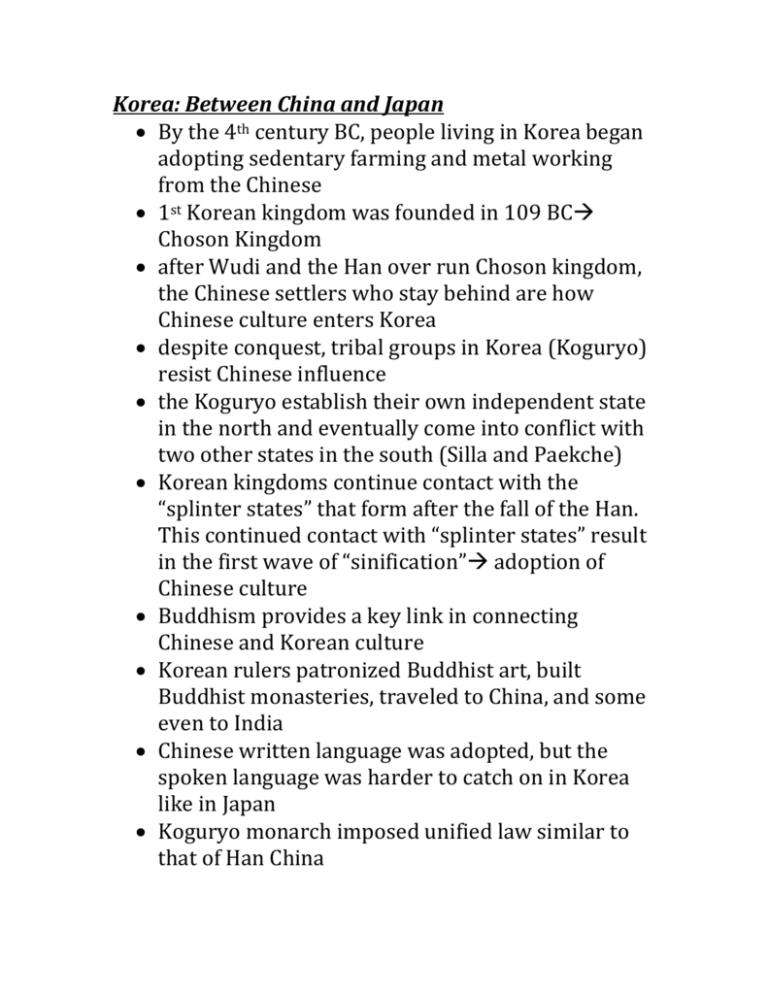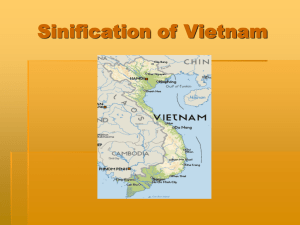Ch 13 290-295
advertisement

Korea: Between China and Japan By the 4th century BC, people living in Korea began adopting sedentary farming and metal working from the Chinese 1st Korean kingdom was founded in 109 BC Choson Kingdom after Wudi and the Han over run Choson kingdom, the Chinese settlers who stay behind are how Chinese culture enters Korea despite conquest, tribal groups in Korea (Koguryo) resist Chinese influence the Koguryo establish their own independent state in the north and eventually come into conflict with two other states in the south (Silla and Paekche) Korean kingdoms continue contact with the “splinter states” that form after the fall of the Han. This continued contact with “splinter states” result in the first wave of “sinification” adoption of Chinese culture Buddhism provides a key link in connecting Chinese and Korean culture Korean rulers patronized Buddhist art, built Buddhist monasteries, traveled to China, and some even to India Chinese written language was adopted, but the spoken language was harder to catch on in Korea like in Japan Koguryo monarch imposed unified law similar to that of Han China Education focused on Confucianism and China rather than Korea Tang Alliances and Conquest of the West The Tang took advantage of the political divisions in Korea to help themselves conquer all three kingdoms (Silla, Paekche, and Koguryo) The Tang withdraw in 668 and leave the Silla in control of a newly unified Korea Sinification: the Tributary Link Chinese culture peaked between 668-1392 in Korea Silla initially intended to turn Korea into a miniature Chinese state by: 1. Spending tribute to Chinese 2. Sending embassies to the Tang court The tributary system provided privileged access to Chinese learning, goods, art, and culture The Tribute System became the main source of exchange between the Koreans, the Japanese, the Vietnamese, and the Chinese Sinification of Korean Elite Culture Silla rulers rebuild the capital at Kumsong to look like the Chinese counterpart Most elite Koreans lived in Kumsong to avoid the “backward rural areas” Some aristocrats studied in Chinese schools, and some even took civil service examinations Korean elite preferred Buddhism over Confucianism Koreans borrowed techniques of porcelain manufacturing from Chinese, and then improved the quality by experimenting with Korean techniques Koreans also improved the Chinese art of printing with honey Civilization for the Few Imports of Chinese culture were experienced primarily by the elite classes Trading with Japan and China was aimed at improving the lives of the elites Korean exports consisted of: forest products and metals ***the aristocrats were the “only people who really counted for anything in Korean society” Koryo Collapse, Dynastic Renewal periodically, the lower classes got tired of the monotony and rebelled their boring lives these peasant rebellions and outsider invasions helped sink the Koryo and Silla dynasties after the fall of these two dynasties, the aristocracy brought about the Yi Dynasty (1392-1910) Between China and Southeast Asia: the Making of Vietnam the Viet people feared becoming engulfed by China’s culture, and thus made extensive efforts to remain separate 1st and 2nd centuries BC, the Chinese traded silk to the Vietnamese in exchange for ivory, tortoise shells, pearls, peacock feathers, aromatic woods, and other luxury goods Vietnamese people favored the “immediate family” over the “extended family” Women in Vietnam experienced more influence and greater freedom than their counterparts back in China Vietnamese dressed DIFFERENTLY than the Chinese Vietnamese women “blackened” their teeth, which was repulsive to Chinese women The Vietnamese stick to Buddhism ideologically, and developed art and literature that was distinctly Vietnamese Conquest and Sinification The Han ruler initially accepted the Vietnamese admission as a “vassal” state with payments of tribute In 111 BC, they decide to invade and conquer Vietnam In the next centuries, Vietnamese elite were drawn into the Chinese bureaucracy Vietnamese children attended Chinese-styled schools, wrote in Chinese script, and studied Confucian ideals The Vietnamese introduced irrigation and agricultural techniquesexplains with Vietnam had one of the highest population densities in Asia at the time The Viet people also adopted the political and military organization of China Over time, the Vietnamese change their minds on this notion of “immediate family” over “extended family”






